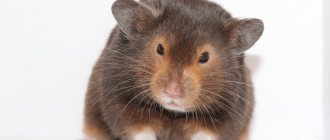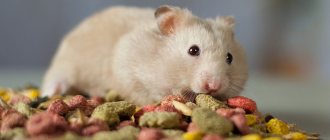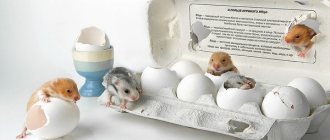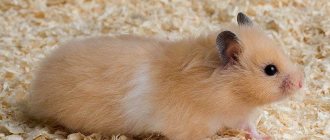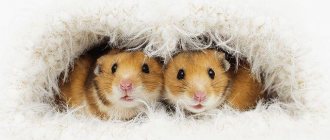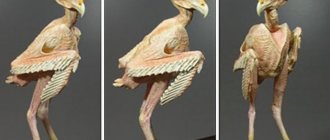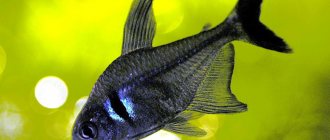Origin of Syrian hamsters
The species was first described by a 19th century zoologist. George Robert Waterhouse. In 1839, the scientist worked on compiling catalogs of mammals and birds brought by Charles Darwin from his trip around the world. Among the specimens was a Syrian hamster. Then, for a long time, this rodent was not encountered by natural scientists during their expeditions. It was considered extinct.
The Syrian hamster is also called the Central Asian hamster.
Only in 1930, near the Syrian city of Aleppo, another representative of this breed was found. Israeli biologist Israel Aharoni managed to find a pregnant female, who soon gave birth to 11 cubs. Within a year, Professor Aharoni had 150 rodents. After a couple of years, there were so many animals that he was able to send them to his colleagues in America and Europe, where they became widespread.
Description of the breed
The anatomy of the golden hamster allows it to carry large volumes of food that other rodents of similar size cannot carry at once. This is possible thanks to the cheek pouches. When filled, they double the volume of the head.
The animal is distinguished by its overall stockiness and short limbs. The front paws have 4 toes, and the hind paws have 5.
Habitat
Natural habitat - Central and South Asian steppes, Persian Gulf countries. There are representatives of the breed in Africa, Europe and America. Animals often choose to live in cultivated areas, parks and vegetable gardens - rich sources of food. Now wild individuals are rare. These are either pets or laboratory specimens.
Syrian hamsters are considered picky animals. They can adapt to living in almost any conditions.
Coat color and length
Syrian hamsters come in short-haired and long-haired varieties. Do not cross these species, because... the cub may become the owner of wool that does not fit into the breed standards.
The following color options are available:
- golden;
- black;
- white;
- yellow-brown;
- cream;
- dark grey;
- pearl;
- Agouti is a zoned coat color.
The most common shades are cream and golden. Coat color can change throughout the animal's life. Basically it becomes darker.
Thanks to the variety of types of Syrian hamsters, everyone can choose a pet to suit their taste.
Length and weight
Compared to their other relatives, Syrian rodents are quite large: body length is 13 cm or more, weight - 125-150 g. Females are larger than males.
Scent glands
The presence of scent, or marker, glands is a distinctive feature of golden hamsters. The glands secrete a special secretion that rodents use to mark their territory. Visually, these are 2 symmetrical black spots on the sides of the animal. The spots can be barely visible, or they can stand out strongly, having a rough surface and more like warts. Males have more pronounced glands. The rodent can rub its sides against the cage to leave a secret there and claim its territory.
A change in the appearance of the marker glands is a reason to consult a veterinarian. This may be a consequence of the development of inflammatory processes or cancer.
Character and lifestyle
The Syrian hamster, like many of its relatives, is more active at night. This is due to the peculiarities of the life of rodents in the wild, where they are forced to hide from predators. Twilight is a natural shelter. The animal was domesticated relatively recently, so its genetics and lifestyle did not have time to adapt to the new rhythm.
In their natural habitat, rodents dig tunnels and strive to create a home and pantry for themselves - a place to store supplies. If resources allow, the animal is capable of making supplies whose weight will exceed its own 100 times.
Under natural conditions, Syrian hamsters live in shallow burrows and are active at night.
The main behavioral characteristic of animals is activity. They are curious and friendly, but can become aggressive when frightened. To avoid this, pick up your pet carefully, without sudden movements. Give him time to get used to your smell and offer him a treat. This way the hamster will be more willing to make contact.
Rodents have intelligence, are able to recognize their owner and respond to a name.
Lifespan
On average, these pets live 2-3 years. Life expectancy directly depends on the conditions of detention and proper care.
How to determine gender?
The female and the male have their own distinctive characteristics not only in character, but also in appearance. Knowing the gender is important if you are going to keep several animals together. Two females in one house will never get along, but with males things are simpler. To avoid unexpected offspring, it’s worth finding out who you put in the same cage. It is better to determine the sex of an animal older than a month. Here are the main ways:
- In February it is easier to identify a male, since his testes are swollen and his testicles are more visible.
- The female has a rounded back, while the male has a sharp back. This difference is noticeable when viewed from above.
- The male has two nipples on the abdomen, and the female has four.
- If upon examination it appears that there is only one outlet, then it is definitely a girl. For boys, the distance between them is greater.
- The female's belly has denser fur.
Selection and arrangement of the cage
In the wild, animals are active and mobile. A properly selected cage will allow the animal to live in its usual rhythm and will be the key to its good health.
Requirements
The more spacious the cage and the more tiers it has, the better. Hamsters love stairs and passages. The rods should be metal: they let in a lot of light and air, and it is impossible to chew through them. It is better to choose a plastic tray: it is easy to care for and does not absorb odors. A mandatory element of the home is a special house where the hamster will hide and stock up.
Syrian hamsters are relatively large in size, so a small cage is not suitable for keeping such a pet.
Drinker and food bowls
When choosing a bowl for food, it is better to give preference to a ceramic one, because... it is more stable compared to plastic. Place it on one of the upper tiers - this will protect the container from dust and debris.
Ceramic dishes can also be used for water, which should always be in the cage. The sides should not be high so that the hamster does not have to stretch. Sometimes inexperienced breeders have concerns that the animal may accidentally choke when left unattended. But this option of supplying water is considered more natural and convenient for the animal. If you choose the right bowl and pour no more than 100 ml of liquid, no harm will happen.
There are special sippy cups in the form of bottles. They are attached to the cell walls using suction cups or hooks. The rodent receives water through a straw. The water in such a drinking bowl is protected from dust and debris. But the bottle requires careful care. If hygiene is poor, mold will quickly form inside.
Sports area
Sports activity is an important factor influencing the lifespan of a Syrian hamster. A running wheel should be a must-have exercise machine. It is better to choose a model without crossbars and with a small distance between the rods so that the animal’s paws do not fall through. Securely attach the exercise machine to the wall of the cage or install it inside using a special stand.
If space allows, add mazes and obstacle courses. This will diversify your pet’s leisure time and provide additional physical activity.
Filler
The bottom of the cage must be sprinkled with a layer of filler. It is needed to neutralize odor and absorb pet waste. Pressed sawdust is well suited for these purposes. They will not cause harm if the animal decides to chew them a little or use them to decorate their home.
Good bedding for a hamster's cage is no less important than quality food.
Cleaning
You need to keep order in your rodent’s home every day: change water and food, spot remove dirty litter, throw away spoiled food. Wash the cage once a week and completely change all the litter. It is recommended to use gentle cleaning agents without a strong odor. To remove heavy stains, use a weak solution of vinegar.
Supplies in the house should be periodically reviewed, but if the food has not spoiled, do not throw it away.
Additional accessories
When you equip the cage with everything necessary for a comfortable life for your pet, take a closer look at the accessories. They won't let your pet get bored. There is a wide choice: hammocks, plastic and plush tunnels, slides, cotton wool nests, rings and even special play complexes.
Syrian hamster nutrition
The activity, immunity and lifespan of a rodent largely depend on its diet. To create a balanced menu, you need to know the feeding behavior of an animal in the wild.
Mode
The hamster is a nocturnal animal, its activity time falls at dusk.
Divide the daily amount of food into 2 meals. In the evening, the portion of food should be larger than in the morning.
Diet
In their natural habitat, the diet of rodents includes the following components:
- cereal grains;
- greens, fruits and vegetables;
- insects and worms, i.e. protein.
You need to feed your pet in a balanced manner at home.
The Syrian hamster's diet should be well balanced.
The hamster's diet consists of cereals:
- wheat:
- rye;
- oats;
- corn;
- millet.
Add peanuts, nuts, dried peas, sunflower seeds, watermelon and melon to your menu.
You can buy ready-made cereal mixture. If you prepare the food yourself, keep in mind that peanuts and nuts are high in fat. Their content in the total mass of the finished product should not exceed 10%.
Feed your rodent plant foods daily.
It can be greens, clover, plantain, lettuce, parsley, dill. It is better not to include wormwood and dandelion (especially its stems) in the animal’s diet.
Fresh vegetables allowed:
- carrot;
- cucumber;
- zucchini;
- radish;
- Bell pepper.
The following fruits are suitable as a treat:
- apples;
- bananas;
- pears;
- peaches.
It is not worth giving them often, because... they contain a lot of sugar. For the same reason, dried fruits should be excluded from the rodent’s diet. But you can treat your hamster with berries every day.
On average, a rodent should receive about 30 g of cereals, 20 g of vegetables and herbs every day. Additionally, you can offer your pet 1-2 nuts and a few pieces of fruit.
Several times a week the animal should receive 5 g of protein food.
Low-fat cottage cheese, boiled eggs and chicken are suitable. In pet stores you can purchase insects and worms specifically designed for feeding.
Toys for grinding teeth
Rodents' teeth constantly grow. Give your pet a tree branch to grind them down. Recommended are beech, apple, birch, oak, cherry, pear, birch, and willow. Coniferous tree branches should not be given.
The mineral ring must be kept in the Syrian hamster's cage at all times.
There are special mineral stones for rodents on sale. They not only help to grind teeth, but also add useful substances to the pet’s diet: calcium, phosphorus, iron, selenium.
Content Features
Hamsters can be kept in aquariums or cages. The second option is more convenient and popular. It is important for the rodent to provide space and good bedding, since the natural need for the animal is to dig holes. The substrate in the animal's house can be paper, special filler, or wood shavings . The main thing is that the raw material is light and absorbs liquid well.
The animals will also need material to build a nest. Cuts of paper will do the job well.
Sources:
https://kotiko.ru/homjaki/raznovidnosti-homjakov/okrasy-sirijskih-homjakov-chernyj-belyj-zolotistyj-i-drugie-foto.html https://homjakam.ru/vidy/okrasy-sirijskih-homyakov https: //vplate.ru/homyak/sirijskiy/
Rules for caring for a Syrian hamster
Syrian hamsters are easy to care for. For a pet to live comfortably, it is necessary to keep the cage clean and provide regular and balanced nutrition.
Walks and games
If the animal's cage is equipped with everything necessary, then it does not require additional walks.
If you want to let your pet roam around the apartment, purchase a special ball. The hamster will not be able to escape from it and will always be in sight.
What not to do
You should not let your hamster out on the street: in the grass you will quickly lose sight of him.
Protect the animal from falling from heights. The bones of his skeleton are fragile, and any fall can end sadly, even fatally. Be careful when handling your pet. Don't leave him outside his cage unattended.
Special colors
During the process of domestication, some species of hamsters received separate names, indicating their rare, unusual appearance. For example: Persian, Angora, Himalayan, Royal or other hamsters.
There are photos of hamsters of various colors on the Internet. Syrians are not only monochromatic. Uneven color is expressed by various spots and color transitions.
- The Royal Hamster is a rare species of Syrian. Long-haired rodents of light cream color. Sometimes the fur is ivory-colored. The base of the pile is white. The middle may contain red and honey shades. The ears are dark, gray or brown.
- The coat of satin hamsters can be of any length. The fur is smooth with a pearlescent tint.
- Angora hamsters have the longest fur of all Syrian varieties.
- The Persian hamster is a fluffy, light-colored creature. Sometimes the coat has a tangerine, honey or cream tint. It is quite rare.
- Rodents with variegated colors are called butterflies due to the unusual pattern.
- Albinos are creatures without color pigment. They are often confused with white hamsters.
- Rodents with fur that looks like rain stains are called “rain”. The name is quite unusual, but it suits hamsters with gray skin with dark and light streaks.
- Spotted hamsters are the rarest species, bred recently. A black-and-white animal with bright black spots, like a Dalmatian. You cannot buy such a pet in a regular pet store.
- “Tortoiseshell” animals are more common. Their fur is strewn with spots of various shades.
- Rare representatives of Siberian hamsters are lilac and blue animals. This is explained by the fact that it is quite difficult to breed an animal with a purple tint to its coat.
The Siberian hamster is easy to care for, unpretentious in diet, and friendly. Therefore, it is increasingly being chosen as a pet. The variety of colors of Syrian hamsters is amazing. You need to work hard to choose one pet.
Article on the topic: Eversmann's hamster
Reproduction of Syrian hamsters
Rodents reach sexual maturity at 6 weeks. But for breeding it is better to choose individuals no younger than 4-6 and no older than 18 months. Avoid crossing blood relatives, because this can lead to genetic mutations and deformities in the offspring.
After birth, you should not touch the cubs with your hands, otherwise the female is able to eat all her offspring if she senses the presence of foreign odors.
Pregnancy period
A pregnant female should be fed protein foods and kept separate from other hamsters, because she can be aggressive. Gestation lasts about 16 days.
Offspring
From 8 to 12 individuals are born in a litter. The lactation period is 20 days. If you do not provide the female with adequate nutrition during pregnancy and feeding her offspring, she may eat her cubs.
Interesting facts and myths
In ancient times, hamsters were associated with evil spirits and witchcraft.
A hamster is not a toy, but a pet that requires attention and proper care.
Now they are shrouded in completely different myths:
- These are living toys. A hamster should not be considered a toy. It requires care and respect. The animal can be tamed, but it will take effort.
- It is impossible to get rid of the cage smell. If the filler is replaced in a timely manner, there will be no unpleasant odors. The hamster is clean.
- The pet does not need water. This is wrong. Without drinking water, the animal will die.
Interesting Facts:
- The animals are used in laboratory research. They are susceptible to human viruses and have a similar tooth structure to ours.
- Matriarchy reigns among rodents of this species. The female is larger than the male and decides who will be the father of the offspring.
- In England there is a club of golden hamster lovers, which publishes its own newspaper and regularly selects a hamster of the month.
Additional shades
The colors of Syrian hamsters are not limited to those listed above. Let's look at less common, but no less popular colors.
Beige
The color of the beige rodent was obtained by crossing gray and red animals. The wool may contain light orange notes. The abdomen is ivory-colored and the base of the pile is grayish. Distinguished by dark ears, a brown spot on the chest and stripes on the cheeks. The fur shimmers in the sun with warm shades: pink, orange, peach.
Article on the topic: Turtle eggs (pregnancy and laying): how to understand that a turtle is pregnant, how egg laying occurs and what the sex of the embryo depends on
Cinnamon
The red-haired pet has a bright copper-orange coat. Sometimes the pile is brick-colored. The animal is distinguished by a white or cream crescent on its chest, as well as bluish stripes on its cheeks.
Brown
The animal is light red or sandy in color. Sometimes golden and brick shades appear on the fur. The tummy is milky, less often sugar. There are brown stripes on the cheeks.
Copper
The Syrian hamster is copper-colored with grayish ears. Sometimes there are representatives with white paws and a light chin.
Cream
The Syrian golden hamster is similar to its cream-colored counterpart. This variety is also popular. The coat is uniformly colored creamy. The belly can be of other colors: pink and orange. Thanks to the mixture of pink and orange, the animal resembles a ripe fruit. That's why peach Syrian is so popular.
Chocolate
Chocolate hamsters have a deep brown coat. The roots of the lint are similar to milk or white chocolate. The ears are black, the chin and paws may be white. The color of a hamster can change over time - lighten or darken.
Yellow
Fluffy rodent with bright yellow fur. The base of the hair is white or light beige. The ears are contrasting - brown or black. There is a caramel or lemon spot on the chest. The yellow tint is persistent when crossed. Therefore, the offspring of a yellow animal and an individual with a different color will most likely turn out to be yellow. Perhaps the fur coat will become less bright.
Honey
The color of the animal resembles honey. There is a dark spot on the stomach. Sometimes the coat has a cream or caramel tint. Hamsters get honey coloring from their mother (females can get it from their father).
Smoky pearl
This variety of Siberian rodents is ashy-colored with creamy inclusions. The breast is lighter or darker than the main coat. In the sun, the fur shimmers like a pearl.
Chocolate sable
The animal has a coat that resembles milk chocolate. Hair roots look like white chocolate. The animal becomes lighter with age. The ears are dark and there are light brown circles around the eyes. Sometimes there is a white chin or “bracelets” on the paws.
Article on the topic: Chinese hamster - a rare pet
Blue mink
Pets have a gray coat with a blue tint and a slight brown tint. The roots of the pile are milky. Bracelets and a white chin are allowed.


